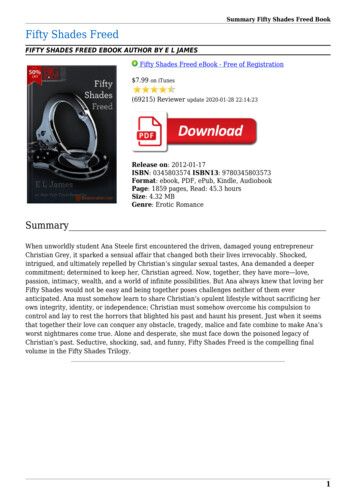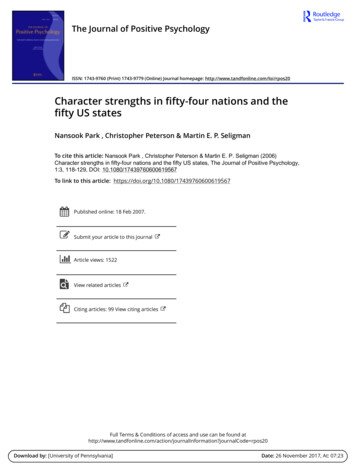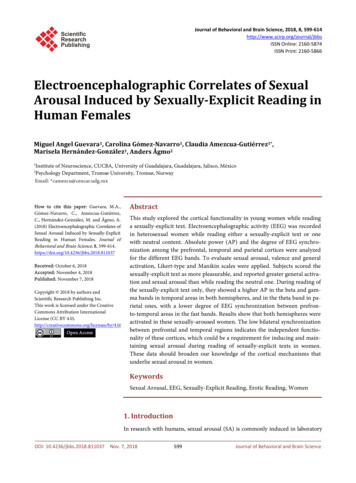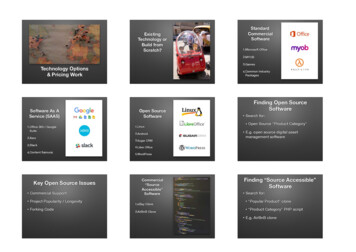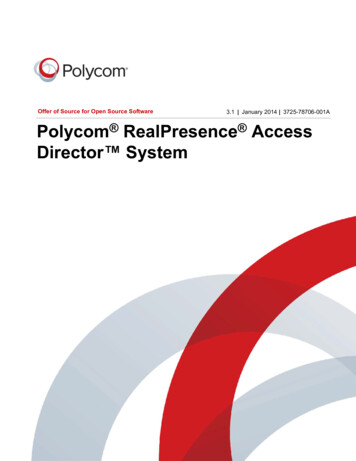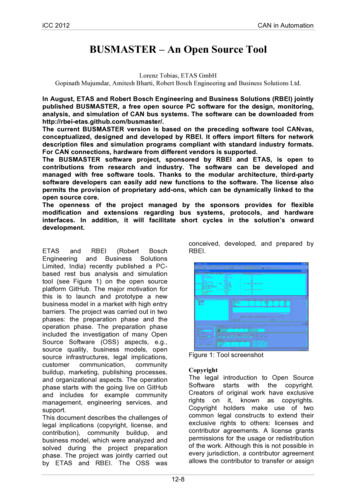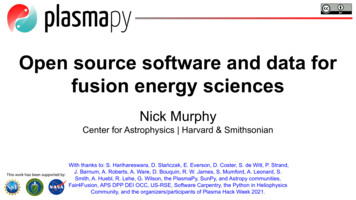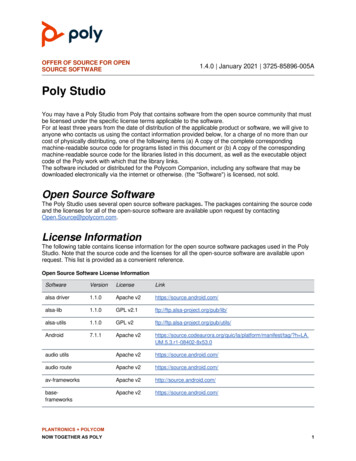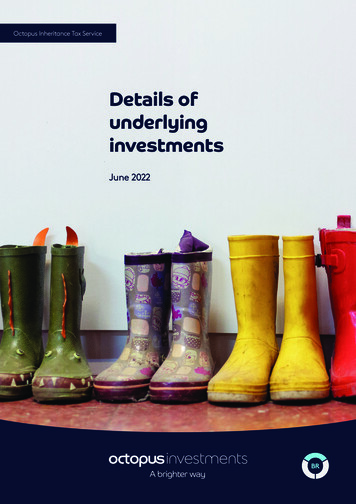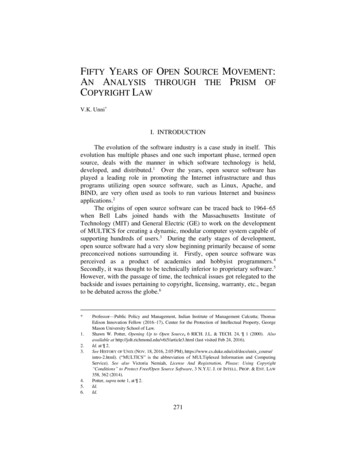
Transcription
FIFTY YEARS OF OPEN SOURCE MOVEMENT:AN ANALYSIS THROUGH THE PRISM OFCOPYRIGHT LAWV.K. Unni*I. INTRODUCTIONThe evolution of the software industry is a case study in itself. Thisevolution has multiple phases and one such important phase, termed opensource, deals with the manner in which software technology is held,developed, and distributed.1 Over the years, open source software hasplayed a leading role in promoting the Internet infrastructure and thusprograms utilizing open source software, such as Linux, Apache, andBIND, are very often used as tools to run various Internet and businessapplications.2The origins of open source software can be traced back to 1964–65when Bell Labs joined hands with the Massachusetts Institute ofTechnology (MIT) and General Electric (GE) to work on the developmentof MULTICS for creating a dynamic, modular computer system capable ofsupporting hundreds of users.3 During the early stages of development,open source software had a very slow beginning primarily because of somepreconceived notions surrounding it. Firstly, open source software wasperceived as a product of academics and hobbyist programmers.4Secondly, it was thought to be technically inferior to proprietary software.5However, with the passage of time, the technical issues got relegated to thebackside and issues pertaining to copyright, licensing, warranty, etc., beganto be debated across the globe.6*1.2.3.4.5.6.Professor—Public Policy and Management, Indian Institute of Management Calcutta; ThomasEdison Innovation Fellow (2016–17), Center for the Protection of Intellectual Property, GeorgeMason University School of Law.Shawn W. Potter, Opening Up to Open Source, 6 RICH. J.L. & TECH. 24, ¶ 1 (2000). Alsoavailable at http://jolt.richmond.edu/v6i5/article3.html (last visited Feb 24, 2016).Id. at ¶ 2.See HISTORY OF UNIX (NOV. 18, 2016, 2:05 PM), https://www.cs.duke.edu/csl/docs/unix course/intro-2.html). (“MULTICS” is the abbreviation of MULTiplexed Information and ComputingService). See also Victoria Nemiah, License And Registration, Please: Using Copyright“Conditions” to Protect Free/Open Source Software, 3 N.Y.U. J. OF INTELL. PROP. & ENT. LAW358, 362 (2014).Potter, supra note 1, at ¶ 2.Id.Id.271
272Southern Illinois University Law Journal[Vol. 40II. GENESIS OF COMPUTER PROGRAMMINGTo get a holistic view of the legal issues arising out of open sourcesoftware and its development, a brief introduction to software programmingwill be beneficial. In fact, the word “source” in open source refers tosource code, which is the language that programmers use to communicateto computers and direct the machines to execute desired functions.7Scholars often refer to source code as the “holy grail” of the open sourcemovement.8Interestingly, programmers never communicate directly withcomputers, as the latter cannot understand any word in the source code.9Computers can only understand another type of language, typically referredto as object code or executable code, which is a binary language ofconsecutive ones and zeros used to control on/off switches in the computerhardware.10 Programmers utilize numerous programs like C, BASIC, andJAVA to write the source code, which is very much readable andunderstood by humans. Source code for a computer program is written in ahigh-level language, such as C or FORTRAN. But if the computer has toperform the programmer’s directions, then the source code needs to beconverted into the computer-readable object code.11 This process, calledcompilation, is usually carried out by standardized compiler software.12A. Importance of Source CodeThe differentiation between the source code and object code is a veryimportant one in the context of open source.13 This distinction alsobecomes the foundation stone for differentiation between traditionalproprietary software and open source software. The most importantdifference between open source and proprietary software is the manner ofdevelopment and distribution.147.8.9.10.11.12.13.14.Mathias Strasser, A New Paradigm in Intellectual Property Law? The Case Against OpenSources, 2001 STAN. TECH. L. REV. 4. ¶ 8, (2001).Greg R. Vetter, The Collaborative Integrity of Open-Source Software, 2004 UTAH L. REV. 563,578 (2004).See Source Code, THE TECH TERMS COMPUTER DICTIONARY (2007), available athttp://techterms.com/definition/sourcecode (Accessed Feb. 5, 2016).Potter, supra note 1, at ¶ 7. See also Executable Code, PC MAGAZINE ENCYCLOPEDIA (2016),available at table-code.Christian H. Nadan, Open Source Licensing: Virus or Virtue? 10 TEX. INTELL. PROP. L.J. 349,350 (2002).Id.See Potter, supra note 1, at ¶ 7.Matthew D. Stein, Rethinking UCITA: Lessons From the Open Source Movement, 58 ME. L. REV.157, 160 (2006).
2016]Open Source Movement273Commercial software developers have utilized the proprietary modelfrom the early days and this involved keeping the source code secret whilesoftware was distributed in the object code form only.15 When a program isdistributed in object code format, the user cannot do anything other than runthe program on a computer.16Most commercial software licenseagreements prevented the user/licensee from having access to the sourcecode. The reason for this stemmed from the fact that distribution ofsoftware in source code form could result in reverse engineering of the firstprogram by any other skilled engineer leading to misappropriation of itsinnovative features. This model of software distribution has been fiercelycriticized by proponents of open source software who often compare theproprietary distribution model to selling a car with the hood welded shut.17Even though a substantial segment of ordinary users are not concernedabout the source code, there still exists a significant section ofprogrammers, professionals and hobbyists who would be interested inknowing about the ideas and concepts behind the program by gainingaccess to the source code. Thus open source software owes its origins to agroup of programmers who share their source code with each other anddistribute their software along with the source code. The hallmark of theopen source approach is built upon the principles of source code access andthe ability to change and improve the source code.18Thus in the field of software two different licensing models operate.19One is a closed model where users are not given access to the source codeand most of the intellectual property is protected as a secret wherein theprogram is released only in its object code version.20 Under the secondmodel, called open model or open source model, users are given access tothe source code and all of the software copyrights are made available to themarket by providing a very liberal license.2115.Dennis M. Kennedy, A Primer on Open Source Licensing Legal Issues: Copyright, Copyleft andCopyfuture, 20 ST. LOUIS U. PUB. L. REV. 345, 346 (2001).16 . In the object code version, the user cannot make any alterations or integrate it with some othersoftware, or study it to see how it functions, and for doing all the aforesaid things access to thesource code is required.17. Stein, supra note 14, at 160.18. Kennedy, supra note 15, at 346.19. Software is generally licensed, not sold, and the reasons for this are explained in the later portionsof this article.20. Daniel B. Ravicher, Facilitating Collaborative Software Development: The Enforceability ofMass-Market Public Software Licenses, 5 VA. J.L. & TECH. 11, ¶ 29 (2000). Also available r, (last visited Feb. 4, 2016).21. Id. at ¶ 30.
274Southern Illinois University Law Journal[Vol. 40III. PROTECTION OF SOFTWARE UNDER COPYRIGHT LAWThe United States of America (“U.S.”) and the United Kingdom werethe first countries to afford protection to computer software within theambit of intellectual property legislation.22 Even though copyright law wasbeing used to protect authors of literary, artistic, musical and dramaticworks in the early days of computer programming, software was notprotected under copyright law.23 Later on as technology progressed, newand different modes of expression, including software, received copyrightprotection.24 Copyright law provides software developing companiesnumerous benefits and virtually no drawbacks, and its greatest advantage isthat it protects them against verbatim copying, an act which makes themmost vulnerable.25However the most difficult issue in copyright protection is to pinpointthe exact nature and scope of monopoly granted by such protection.Copyright protects both the source code and the object code of computerprograms.26 In the U.S., the Copyright Act has provided for restrictionsabout the scope of protection for all works by stipulating that “copyrightprotection for an original work of authorship does not extend to any idea,procedure, process, system, method of operation, concept, principle, ordiscovery, regardless of the form in which it is described, explained,illustrated, or embodied in such work.”27One of the landmark cases, which dealt with the issue of an ideaexpression dichotomy in the context of software, arose in the year 1986.28That case, which was decided by the Court of Appeals for the Third Circuit,involved a copyright infringement action concerning a software programwritten to manage the operation of a dental laboratory. 29 In that case theappellant, Jaslow Dental Laboratory, Inc., was manufacturing dentalprosthetics and devices. Plaintiff-appellee Whelan Associates, Inc. wasalso a company in the business of developing and marketing customcomputer programs.3022.23.24.25.26.27.28.29.30.Nancy Kemp DuCharme & Robert F. Kemp, Copyright Protection for Computer Software inGreat Britain and the United States: A Comparative Analysis, 3 SANTA CLARA COMPUTER &HIGH TECH. L. J. 257, 260–61 (1987).Id. at 261.See 17 U.S.C. § 117 (1998). (Originally enacted in 1976, the United States Congress amended theComputer Software Copyright Act in 1980, defining “computer program” in the federal copyrightstatute. Since then, courts have generally considered computer programs “literary works” andtherefore protected by copyright).Strasser, supra note 7, at ¶ 35.Apple Comput., Inc. v. Franklin Comput. Corp., 714 F.2d 1240, 1249 (3d Cir. 1986).17 U.S.C. 102(b) (1990).Whelan Assocs. v. Jaslow Dental Lab., Inc., 797 F.2d 1222 (3d Cir. 1986).Id. at 1225.Id.
2016]Open Source Movement275Before the district court, the plaintiff and defendants claimed“exclusive proprietary rights to a computer software system developed as acomplete computer business management and control program for theoperation of dental laboratories.”31 Defendants rejected this claim andcontended that their program was developed independently and thus therewas no copyright infringement.32 The District Court held against thedefendant by holding that its program, although written in a differentcomputer language than the plaintiff’s, was substantially similar toplaintiff’s program.33 This substantial similarity, with defendant’sacknowledged access to the plaintiff’s program, led the district court toissue judgment in favor of the plaintiff. The defendant appealed to theThird Circuit Court of Appeals.34The Court of Appeals noted that the main question it confronted inWhelan was “whether mere similarity in the overall structure of programs[could] be the basis for a copyright infringement, or, put differently,whether a program’s copyright protection covers the structure of theprogram or only the program’s literal elements, i.e., its source and objectcodes.”35 It further held that the idea of the impugned program was the“efficient management of a dental laboratory,” which had significantlydifferent requirements from those of other businesses.36 That idea “couldbe accomplished in a number of different ways with a number of differentstructures,” the structure of the program, therefore, was part of theprogram’s expression rather than its idea.37 The Whelan court affirmed thedecision of the District Court, and held that the structure, sequence, andorganization of the parties’ programs were substantially similar.38 Thus thecourt held that the program’s copyright protection also covered the structureof the program apart from the program’s literal elements like source code.39This decision brought the structure, sequence, and organization of acomputer program within the ambit of copyright protection.4031.32.33.34.35.36.37.38.39.40.Whelan Assocs. v. Jaslow Dental Lab., 609 F. Supp. 1307, 1316 (E.D. Pa. 1985).Id.Id. at 1321.Whelan, 797 F.2d at 1232.Id.Id. at 1236 n.28.Id. at 1236.Id. at 1243.Id.Id. at 1244.
276Southern Illinois University Law Journal[Vol. 40A. Abstraction, Filtration, Comparison TestAfter six years, in Computer Associates, Int’l v. Altai, Inc.,41 theSecond Circuit Court of Appeals was once again involved in deciding asimilar case.42 In this case, the plaintiff created a computer programcontaining a sub-program that enabled the primary program to run ondifferent operating systems.43 The defendant hired a former employee ofthe plaintiff, who misappropriated copies of the plaintiff’s source, which heused to create a program for Altai.44 After learning of the employee’scopying, Altai rewrote its program, leaving out the portions that had beencopied from Computer Associates’ subprogram.45 Plaintiff sued forcopyright infringement, arguing both versions of defendant’s programviolated its copyrights.46The lower court found the copied program violated ComputerAssociates’ copyright and awarded damages, but found that the rewrittenprogram did not violate the plaintiff’s copyright, and the plaintiffappealed.47 Appellant-plaintiff contended that despite Altai’s rewriting ofits program’s code,48 the resulting program was substantially similar to thestructure of its program.49 The Court of Appeals opined that the approachthe court followed in Whelan,50 which separated idea from expression incomputer programs, relied too heavily on metaphysical distinctions and didnot place enough emphasis on practical considerations.51 Instead offollowing the decision in Whelan, the court in Computer Associatesenunciated an Abstraction Filtration Comparison test.52 To ascertainsubstantial similarity under this test, a court would first break down theallegedly infringing program into its constituent structural parts and “[t]henexamine each of these parts for such things as incorporated ideas,expression that is necessarily incidental to those ideas, and elements that aretaken from the public domain, so that it could then sift out all nonprotectable material.”53 After filtering out these elements, the remaining“kernel” would be compared with the structure of an allegedly 82 F.2d 693 (2d Cir. 1992).See generally id.Id. at 698.Id.Id.Id. at 698–99.Id. at 697.The defendant’s program was named OSCAR.Appellant’s program was names ADAPTER.Whelan, 797 F.2d at 1233.Comput. Assocs., 982 F.2d at 708.Id. (The importance of this test has been reiterated in many subsequent cases including the mostrecent Oracle case; see 750 F.3d 1339 (Fed. Cir. 2014), discussed in Part IX.D., infra.)Id. at 706.
2016]Open Source Movement277program.54 “The result of this comparison [would] determine whether theprotectable elements of the programs at issue were substantially similar soas to warrant a finding of infringement.”55 Finally, the court held that therewas no copyright infringement in Computer Associates.56The abovementioned two cases have contributed a great deal towardthe evolution of a licensing model in software where the user is givenaccess to the program’s source code and, as a result, the user need not beunduly worried about the prospect of litigation involving modification ordistribution of the source code.IV. SOFTWARE LICENSINGEven though copyright can protect software, software developers arenot fully dependent on intellectual property law’s capability to adequatelyprotect their interests.57 Because of the particular nature of software,widespread copying is possible, and copyright law many not be able toprovide 100% protection. Software can be subjected to multipleunauthorized copying without causing degradation in program’s functionalfeatures. This feature, combined with the connectivity amongst softwareusers offered by the Internet, enables rampant copying of softwareprograms without any constraints of space, time or geographies.Thus software distributors have extended the protection offered byintellectual property laws using contract law, in the form of licensingagreements.58 These software licenses help developers and distributors tosubstantially increase the basic protection granted by intellectual propertylaw. For a software licensor, a licensing agreement is better than a sale,because the former allows the licensor to maintain its precious intellectualproperty rights in the program and grant only those rights specified in thelicense.59Secondly, licenses confer considerable flexibility to softwaredevelopers for customizing licenses, like granting an exclusive license to asingle licensee or nonexclusive licenses to several or many licensees.60Furthermore under the first sale doctrine, once the copy of a copyrightedwork has been sold, the copyright owner has no authority to controlsubsequent transfers of that particular tangible copy. These licenses can be54.55.56.57.58.59.60.Id.Id.Id. at 708–11.Apart from copyright law, patent and trade secret law can be used to protect the rights in software.Stein, supra note 14, at 170.One licensor could allow a licensee to make copies of a program, but can limit any distribution ofthose copies.Ira V. Heffan, Copyleft: Licensing Collaborative Works in the Digital Age, 49 STAN. L. REV.1487, 1496 (1997).
278Southern Illinois University Law Journal[Vol. 40used to circumvent the first sale doctrine, as the doctrine can cover onlysale of software and not licensing of it.61 To attain this objective ofcircumventing the first sale doctrine software developers initially relied ona license called “shrink-wrap” licenses to impose contractual obligationsupon licensees.62 The name shrink-wrap license emerged from the mannerin which the software is packaged, where the terms of the agreement arevisible through the shrink-wrap covering on the box, or the package, whichcontains the stipulation that the use of the software is subject to the termsand conditions provided inside the package.63 The validity of these licenseswas upheld subsequently in the famous case of ProCD, Inc. v.Zeidenberg.64A. First Sale DoctrineThe first sale doctrine can have serious implications for software.65Since the nature of software is such that it can be copied easily withoutdegrading the program, the first sale doctrine could potentially permit andfacilitate widespread copyright infringement.66 Thus, by structuring thetransaction in the form of a license, the creators of software can circumventthe first sale doctrine.67 Courts have held that a software license is not asale and therefore the first sale doctrine is not applicable to licensingarrangements.68 Thus through licensing agreements, software creators anddistributors get the right to put more stringent restrictions and limitations onthe use of the intellectual property involved in the software than would bepossible if the transaction were classified as a sale.69 The sale of a productplaces substantial restrictions on the degree of control that intellectualproperty rights holders can retain over the product. Thus, if the rightsholder devises a model wherein it retains ownership by merely licensing theproduct to end-users, such drastic limitations do not arise.7061.62.63.64.65.66.67.68.69.70.In the USA, the first sale doctrine is based upon the Supreme Court case of Bobbs-Merrill Co. v.Straus, 210 U.S. 339 (1908), where the Court held that once a valid first sale of a copy of acopyrighted work happened, the copyright owner could no longer have any control over anysubsequent distribution of that copy. The doctrine was codified as 17 U.S.C. § 109 (2008), in the1976 Copyright Act.Heffan, supra note 60, at 1498.Id.86 F.3d 1447, 1450 (7th Cir. 1996).See John A. Rothchild, The Incredible Shrinking First Sale Rule: Are Software Resale LimitsLawful? 57 RUTGERS L. REV. 1, 14-15 (2004) (explaining the ease in which software may beredistributed).Id.Id. at 22–23.Adobe Sys. Inc. v. One Stop Micro, Inc., 84 F. Supp. 2d 1086, 1092 (N.D. Cal. 2000).Heffan, supra note 60, at 1498.Ravicher, supra note 20, at ¶ 34.
2016]Open Source Movement279V. EVOLUTION OF OPEN SOURCEThe history of open source and that of software programminghappened almost at the same time.71 The history of the open sourceapproach begins with an MIT computer programmer named RichardStallman who was disillusioned by the restrictions that software licensesplaced on the use and modification of computer programs. 72 According toStallman, these restrictions prevented the effective and efficientdevelopment of innovative software technology, and he also felt that theselicenses limited the ways in which the software was being developed.73Stallman’s vision and philosophy was that software should be free as inspeech, and he firmly believed that proprietary, commercial development ofsoftware was the main cause for numerous problems dealing with security,loss of innovation, incompatibilities, and so forth, because there are veryfew skilled, independent programmers who could analyze and correctsource code.74After giving serious thought to these issues, Stallman, with the help oflaw professors, published the General Public License, commonly known asthe GPL.75 The GPL is generally referred to as a policy statement cumlicense, because in it Stallman spells out the fundamental philosophy of freesoftware.76When we speak of free software, we are referring to freedom, not price.Our general public licenses are designed to make sure you have thefreedom to distribute copies of free software, that you receive source codeor can get it if you want it, that you can change the software or pieces of itin new free programs; and that you know that you can do these things. 77Thus, Stallman specified the three essential components of freesoftware: the right to distribute software, the right to access the sourcecode, and the right to modify the source code. Thus GPL is widelyconsidered the most stringent open source license because of its copyleft71.72.73.74.75.76.77.See OPEN SOURCE INITIATIVE (2012), available at http://opensource.org/history (last visited Jan.4, 2016). Open Source or Free Software is also called by the name Free and Open SourceSoftware (FOSS), available at http://freeopensourcesoftware.org/index.php?title Main Page (lastvisited Jan. 4, 2016).Kennedy, supra note 15, at 349.Id.Id. at 350.See generally Richard Stallman, Why Open Source Misses the Point of Free Software (Feb.12, 2016, 11:48 AM), he-point.en.html.Id.See PREAMBLE OF GNU GENERAL PUBLIC LICENSE, http://www.gnu.org/copyleft/gpl.html (lastvisited Jan 4, 2016) [hereinafter GNU].
280Southern Illinois University Law Journal[Vol. 40provision.78 The copyleft provision ensures that any follow-on distributionof an open source project or derivative work is only done per the terms andconditions of the GPL open source license. Thereafter, Stallman foundedthe Free Software Foundation (FSF) in 1985 to encourage the developmentand distribution of open source software under the GPL. However the mostsignificant development in the evolution of the GPL is Linux, created byLinus Torvalds, a Finnish computer science student, who developed anoperating system that was more stable than Microsoft Windows NT, at amuch lower cost.79A. Berkeley Software Distribution LicenseAlmost at the same time when Stallman was trying to establish theFSF and promote the GPL, programmers at the University of California atBerkeley were working on improving the Unix operating system.80 Theirefforts closely resembled Stallman’s free software projects in the sense thatprogrammers were given free and open access to source code, and theycould make derivative works in order to fix bugs, improve the software, andfine-tune the program.81 The project also became popular, whicheventually forced them to draft a license called the Berkeley SoftwareDistribution (BSD) License.82 The BSD license allowed licensees to workwith source code and create derivative works.83 Interestingly, the BSDlicense was similar in many ways to Stallman’s GPL, but there was onemajor difference: in the BSD license, there was no requirement that thederivative works must be distributed under the same licensing terms.84Thus, the GPL notion of copyleft is not embodied in the BSD License.B. Mozilla Public LicenseIn 1998, Netscape Corporation released its browser program, NetscapeNavigator, which was also the most popular Internet browser at the time, asan open source project.85 This decision by Netscape eventually led to twokey developments in the history of open source. Firstly, discussions about78.79.80.81.82.83.84.85.Stein, supra note 14, at 182.See LINUX (Nov. 18, 2016, 2:12 PM), http://en.wikipedia.org/wiki/Open-source movement.Andrew Leonard, BSD Unix: Power to the People, From the Code, SALON (February 12, 2016,11:54 AM), http://www.salon.com/tech/fsp/2000/05/16/chapter 2 part ource movement.Kennedy, supra note 15, at 351.Id.Id.See generally DONALD K. ROSENBERG, OPEN SOURCE: THE UNAUTHORIZED WHITE PAPERS(M&T Books 2000), available at http://www.stromian.com/Book/FrontMatter.html (last visitedFeb. 12, 2016).Kennedy, supra note 15, at 353.
2016]Open Source Movement281the licensing issues involved a number of strong proponents of open sourceand paved the way for the publication of a definition on open source.86Secondly, as a commercial developer, Netscape knew the major issuesraised under the existing open source licenses particularly for commercialprojects where the underlying code contained software licensed from alarge number of developers.87Had Netscape wanted to release its browser under an open sourcelicense like the GPL, every underlying licensor of software used in thebrowser would have had to agree to release their incorporated code underthe open source license ultimately chosen by Netscape. Because of thisherculean task, and the difficulties involved in GPL, Netscape decided todraft its own open source license. In order to make the license acceptableto the open source community, Netscape developed the Mozilla PublicLicense (MPL) and this license now serves as an important model of anopen source license useful in situations involving commercial software orcommercial development.88Netscape coordinated with Bruce Perens, who was already involved inthe open source Linux community and was in the process of framing somestandards for open source.89 Perens ultimately gave the Open SourceDefinition.90 The open source definition is a comprehensive statement ofopen source principles, and a way of tracking the licenses that compliedwith the open source definition.91 The Open Source Initiative (OSI) wasalso established as an entity responsible for maintaining the open sourcedefinition, promoting open source, and helping pave the way for continuinginvolvement of commercial entities in open source projects. The OSI isthus a not-for-profit body steering many initiatives in the open sourcecommunity. It deals with the 10 conditions needed for the softwareprogram to be considered as open source.92Firstly, the software license should not limit the licensee from sellingor giving away the software as a component part of a larger softwareprogram.93Secondly, dissemination of the program must includedistribution of the source code, which must be easily accessible.94 Thelicense must also allow the software to be modified and must allow86.87.88.89.90.91.92.93.94.Id.Id. at 354.Mozilla Public License Version 1.1, MOZILLA FOUNDATION, https://www.mozilla.org/enUS/MPL/1.1/ (last visited February 12, 2016).ROD DIXON, OPEN SOURCE SOFTWARE LAW 7 (2004).Id. at 8.Id. See also Open Source Initiative, OPENSOURCE.ORG, http://opensource.org/osd (last visitedJan. 27, 2016).KEN KRECHMER, OPEN SYSTEMS IN DIGITAL CONVERGENCE 117-18 (Sangin Park et al. eds.,2007) (explaining the ten conditions).Id. at 117.Id.
282Southern Illinois University Law Journal[Vol. 40derivative works to be distributed under the same license terms.95Restrictions on such distribution shall only be allowed if patch files areinstead distributed with the source code in order that the program may bemodified at build time.96 The license should not discriminate against anyperson or group of persons, and should not restrict anyone from making useof it in a commercial field.97 Additional licenses are not required forredistribution, and the license must not be product-specific or restrict othersoftware that is distributed along with the licensed software.98 Finally, thelicense must be technology neutral, which essentially means that click-wraplicense is forbidden.99 Interestingly, the GPL, the BSD license and theMozilla Public License are all in conformity with the Open SourceDefinition.100 With the release of the Open Source Definition, theacceptance of the open source style of development and licensing hassubsequently increased a great deal.C. Public Domain Software and Open Source SoftwarePeople tend to confuse open source software with public domainsoftware and thus it is necessary to distinguish the two terms.101 There canbe some software that is released freely into the public domain and in thatthe author will not hold a copyright.102 In the case of open source softwarethis does not happen. Instead, a license governs open source software andthe software’s copyright owners continue to own the copyright and asserttheir rights to it.103 In other words, open sou
access to the source code. Thus open source software owes its origins to a group of programmers who share their source code with each other and distribute their software along with the source code. The hallmark of the open source approach is built upon the principles of source code access and the ability to change and improve the source code.18

